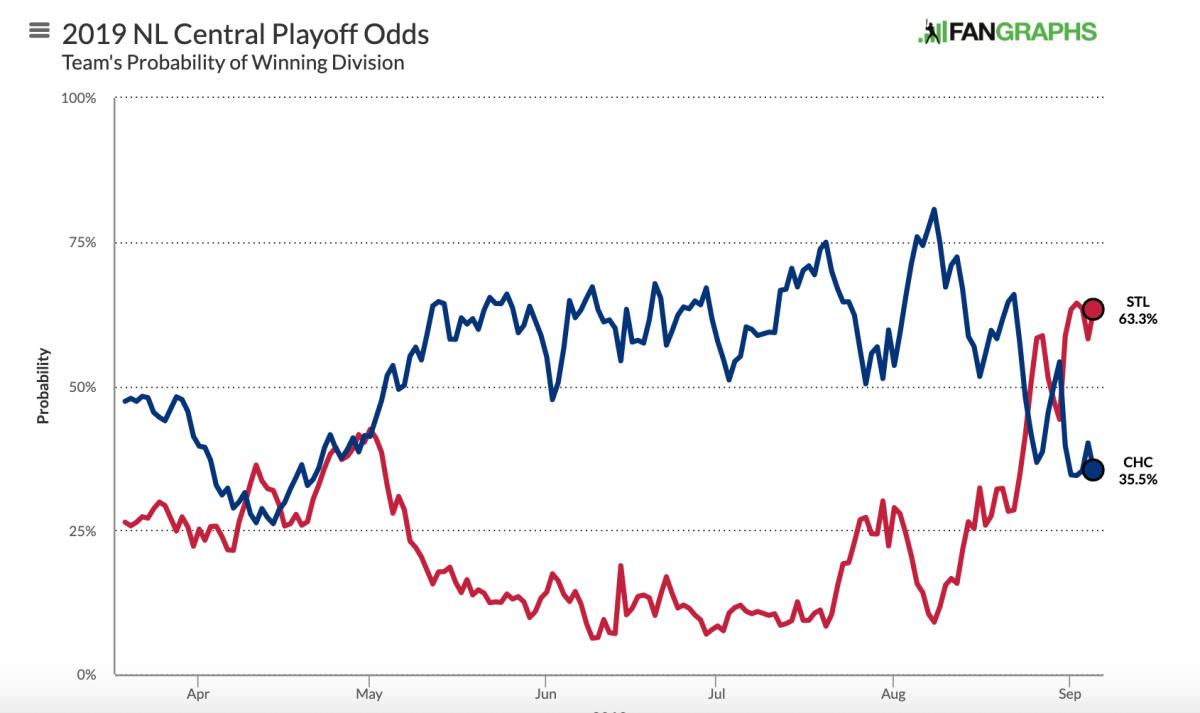Inconsistent Cubs Need Uninterrupted Success Soon to Avoid Disappointing Finish

As they go up, they go down. That’s been the Cubs in the second half, ping-ponging between realistic World Series contender and disappointment, between NL Central champion and the precarious position of facing Max Scherzer in a do-or-die playoff game on the road. And for every step forward that Chicago seems to take, it promptly whirls around and walks right back to the start. Thursday’s about-face: a win over Milwaukee, the team’s third in a row, tempered by the news that closer Craig Kimbrel is headed to the injured list with right elbow inflammation.
A month ago, it was the Cubs holding a modest lead over the Cardinals and Brewers, with a high-water mark of 3 1/2 games on St. Louis in the division as of Aug. 8. The Cardinals have gone 21–6 since that date, though, erasing a gap that had persisted throughout the summer. Where once Chicago was the favorite to claim the Central crown, St. Louis now holds the better odds and a 2 1/2-game lead with just three weeks left in the season.

The saving grace for the Cubs is that, while their schedule grows shorter, it still offers plenty of opportunities to make up the deficit—in particular, seven games left against the Cardinals, all coming in the last week-plus of September. Between the first of those meetings (a four-game series at Wrigley Field starting on the 19th) and now, though, Chicago needs to keep it together, and that’s been the hard part. The Cubs continually give off the impression of a Formula 1 car with a cinder block dragging behind it, unable to get up to speed, or like one that, just as it reaches triple digits in miles per hour, has a wheel come flying off.
Either way, the Cubs have struggled to hold what ground they’ve gained, as the lineup, rotation and bullpen all refuse to click together. August saw Jose Quintana post a 2.02 ERA in 35 2/3 innings and Yu Darvish strike out 42 against a single walk; it also featured Kyle Hendricks, Cole Hamels and Jon Lester all putting up ERAs of 5.20 or worse. Offensively, Nick Castellanos has done his best “2017 J.D. Martinez on the Diamondbacks” impression—just as Javy Baez has fallen into a deep funk (.211/.265/.355 since Aug. 8). Even injury replacements come with karmic balancing: Just as Willson Contreras returns from a month-long IL stint (and picked up four hits against the Brewers), Kris Bryant sees his production sapped by a recurring knee problem that’s held him to a .182 batting average in his last 12 games.
Perhaps nothing better sums up the travails of the Cubs than Darvish. After an uneven start to the season, he’s morphed into an ace, with a 3.19 ERA in 62 innings since the start of July, including a remarkable 78/3 strikeout-to-walk ratio. Yet that turnaround is in jeopardy thanks to right forearm tightness that caused him to miss his last start. The good news is that he’s on track to start on Saturday against Milwaukee; the bad news is that he’s apparently been dealing with discomfort for the last two months. Then again, if he’s put up those results despite the pain, how bad can it really be?
The Cubs will hope “not bad enough to throw him off track,” because they can ill afford that. Not with Hamels toting a 6.33 ERA since coming off the IL in early August or with Lester increasingly looking like a 35-year-old pitcher with 2,500-plus career innings on his left arm. Nor does the loss of Kimbrel help, even with the high-priced closer struggling since joining the North Siders. Likely affected by his long free-agent layoff, he’s posted an ugly 5.68 ERA across 19 innings, including 11 walks and six homers allowed, along with a sizable dip in strikeout rate (from 38.9% last year to 29.5 this season) and velocity (an average of 97.1 mph on his four-seamer in 2018 down to 96.2). And though he’d looked better in August, allowing just one run in seven appearances, a barking elbow will now keep him out for at least the next 10 days.
It’s hard to achieve any kind of consistency when these are the problems you face: aging stars, injured contributors, an offense that for whatever reason is appreciably worse on the road than at home. Unsurprisingly, the Cubs have see-sawed: In August alone, they had three winning streaks of four or more games, but also lost six out of seven at one point and were swept in a three-game set by the wild-card-leading Nationals.
In the balance of all this hangs Chicago's status as one of baseball’s elite teams. Dreams of a dynasty spurred by its 2016 title have given way to diminishing returns and shorter postseason trips. Should this Cubs team also fall short, be it in the wild-card game or beyond, the talk will inevitably turn to a roster squandered, and a front office and manager in need of change. The latter seems almost inevitable, given that Joe Maddon is in the final year of his contract. But if 2019 ends without a championship parade in the North Side, will the former also see a shakeup?
The good news for the Cubs is that missing the playoffs entirely is unlikely. The rest of the NL wild-card field is a sorry bunch, either melting under pressure (the Mets and Phillies) or constitutionally incapable of rising to the occasion. The next closest team to Chicago in the standings is Arizona, which traded its ace away at the deadline. The Cubs shouldn’t have to worry about being caught from behind.
Instead, the focus for the rest of September will be chasing down those in front, be it the Nationals or the Cardinals. To do that, though, will require something the Cubs haven’t gotten all season: uninterrupted success and forward momentum.
